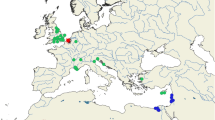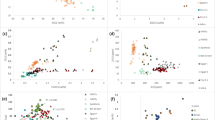Abstract
Glass rinds on small Hessian crucibles from Jamestown are interpreted as samples of the experimental “tryal of glasse” known to have taken place in this early-17th-century Virginia colony Compositional analysis of the rinds indicates that, compared with the glass produced in northern Europe Waldglas), they are strongly enriched in soda and depleted in lime This is hypothesized to result from the use of halophytic plants (sea grass?) in the Jamestown glass batches Imported decorative (beads, dress ornaments) and utilitarian (flat glass, roemer drinking glass) glass items comprise both soda-lime Venetian glass and potash-lime Waldglas, respectively The alkaline/low-Ca ternary composition of Jamestown “tryal” glass thus distinguishes it from these imported wares Environmental changes in the area (e.g., sea-level rise) since the 17th century hamper the identification of locally derived batch ingredients. For example, mass-balance calculations show that the sand used by Jamestown glassworkers was less siliceous than that presently exposed (91% SiO2) on Jamestown Island The novel composition of this “tryal” glass evidently records an adaptation of European glass batch recipes as necessitated by the scarce resources available to the glassworkers at Jamestown.
Similar content being viewed by others
References
Blakelock, Eleanor, Marcos Martinón-Torres, Harald A Veldhuijzen, and Tim Young 2009 Slag Inclusions in Iron Objects and the Quest for Provenance: An Experiment and a Case Study Journal of Archaeological Science 36:1745–1757.
Borg, Ingwer, and Patrick J F Groenen 1997 Modern Multidimensional Scaling, Theory and Applications Springer-Verlag, New York NY.
Brems, Dieter, M Ganio, K Latruwe, L Balcaen, M. Carremans, D Gimeno, A Silvestri, F Vanhaecke, P. Muchez, and P Degryse 2013 Isotopes on the Beach, Part 1: Strontium Isotope Ratios as a Provenance Indicator for Lime Raw Materials Used in Roman Glass-Making Archaeometry 55(2):214–234.
Brill, Robert 1999 Chemical Analyses of Early Glasses, Vols 1 and 2. Corning Museum of Glass, Corning, NY.
Cronin, William T. 2005 The Disappearing Islands of the Chesapeake Johns Hopkins University Press, Baltimore, MD.
De Raedt, Ine, K Janssens, and J Veeckman 1999 Compositional Distinctions between 16th Century “Façon-de-Venise” and Venetian Glass Vessels Excavated in Antwerp, Belgium Journal of Analytical Atomic Spectrometry 14:493–498.
De Raedt, Ine, K Janssens, J Veeckman., L Vincze, B. Vekemans, and T E Jeffries 2001 Trace Analysis for Distinguishing between Venetian and Façon-de-Venise Glass Vessels of the 16th and 17th Century Journal of Analytical Atomic Spectrometry 16:1012–1017.
Dungworth, David 2009 Innovations in the 17th Century Glass Industry: The Introduction of Kelp (Seaweed) Ash in Britain In Les Innovations Verrières et Leur Devenir, S Lagabrielle and M Philippe, editors, pp 119–122 Actes du 2ième Colloque International de l’Association Verre et Histoire, Nancy, France.
Eggins, Steven M., L P J Kinsley, and J M G. Shelley 1998 Deposition and Element Fractionation Processes during Atmospheric Pressure Laser Sampling for Analysis by ICP-MS Applied Surface Science 127(1&2):278–286.
Ettler, Vojtech, R Cervinka, and Z Johan 2009 Mineralogy of Medieval Slags from Lead and Silver Smelting (Bohutin, Pribram District, Czech Republic): Towards Estimation of Historical Smelting Conditions. Archaeometry 51(6):987–1007.
Harding, Juliana M., Howard J Spero, Roger Mann, Gregory S Herbert, and Jennifer L Sliko 2010 Reconstructing Early 17th Century Drought Conditions from Jamestown Oysters Proceedings of the National Academy of Sciences 107(23):549–554.
Harrington, J C. 1972 A Trial of Glasse: The Story of Glassmaking at Jamestown Dietz Press, Richmond, VA.
Hewett, Donnel F. 1916 Some Manganese Mines in Virginia and Maryland. USGS Bulletin 640(1):37–71.
Jackson, Caroline M., and James W Smedley 2004 Medieval and Post-Medieval Glass Technology: Melting Characteristics of Some Glasses Melted from Vegetable Ash and Sand Mixtures Glass Technology 45(1):36–42.
Jackson, Caroline M., James W Smedley, and C M. Booth 2005 Glass by Design? Raw Materials, Recipes and Compositional Data Archaeometry 47(4):781–795.
Jochum, Klaus P., U Weis, B Stoll, D Kuzmin, Q. Yang, I Raczek, E Jacob, D E Dorrit, A Stracke, K. Birbaum, D A Frick, D Günther, and J Enzweiler 2011 Determination of Reference Values for NIST SRM 610–617 Glasses Following ISO Guidelines Geostandards and Geoanalytical Research 35(4):397–429.
Lake, Justin W L., and Derek H C Wilton 2006 Structural and Stratigraphic Controls on Mineralization at the Beaver Brook Antimony Deposit, Central Newfoundland In Current Research (2006), Newfoundland and Labrador Department of Natural Resources Geological Survey, Report 06-1, pp. 135–146 Newfoundland and Labrador Department of Natural Resources, St John’s.
Lobo, Lara, Veerie Devulder, Patrick Degryse, and Frank Vanhaecke 2012 Investigation of Natural Isotopic Variation of Sb in Stibnite Ores via Multi-Collector ICP-Mass Spectrometry––Perspectives for Sb Isotopic Analysis of Roman Glass Journal of Analytical Atomic Spectrometry 27(8):1304–1310.
Martinón-Torres, Marcos, Thilo Rehren, and Ian C. Freestone 2006 Mullite and the Mystery of Hessian Wares Nature 444(7118):437–438.
Orth, Robert J., and Kenneth A Moore 1983 Chesapeake Bay: An Unprecedented Decline in Submerged Aquatic Vegetation Science, new ser., 222(4619):51–53.
Orth, Robert J., D J Wilcox, J R Whiting, L Nagey, A L Owens, and A K Keene 2013 2012 Distribution of Submerged Aquatic Vegetation in Chesapeake and Coastal Bays Manuscript, Virginia Institute of Marine Science, Special Scientific Report Number 154 Gloucester Point Virginia Institute of Marine Science <http://web/vims.edu/bio/sav/sav11/index.html/> Accessed 9 November 2014.
Owen, J Victor 2007 A New Classification Scheme for 18th Century American and British Soft-Paste Porcelains In Ceramics in America 2007, Robert Hunter, editor, pp. 121–140 Chipstone Foundation, Milwaukee, WI.
Owen, J Victor, Katherine L Irwin, Charles L Flint, and John D Greenough 2005 Trace Element Constraints on the Source of Silica Sand Used by the Boston and Sandwich Glass Co (c. 1826–1888), Massachusetts Industrial Archaeology 31(2):39–56.
Rehren, Thilo 2000 Rationales in Old World Base Glass Compositions. Journal of Archaeological Science 27(12):1225–1234.
Schibille, Nadine 2011 Late Byzantine Mineral Soda High Alumina Glasses from Asia Minor: A New Primary Glass Production Group. PLoS ONE 6(4) PLoS ONE <http://www.plosone.org/article/info%3Adoi%2F10.1371%2Fjournal.pone.0018970> Accessed 9 November 2014.
Smedley, James W., and Caroline M Jackson 2002a Medieval and Post-Medieval Glass Technology: A Review of Bracken in Glassmaking Glass Technology—European Journal of Glass Science and Technology 43(6):1–4.
2002b Medieval and Post-Medieval Glass Technology: Batch Measuring Practices Glass Technology—European Journal of Glass Science and Technology 43(1):22–27.
Smedley, James, Caroline M Jackson, and C A Booth 1998 Back to the Roots: The Raw Materials, Glass Recipes and Glassmaking Practices of Theophilus In The Prehistory and History of Glassmaking Technology, Ceramics and Civilization, Vol 8, Patrick McCray and W David Kingery, editors, pp 145–165 American Ceramic Society, Columbus, OH.
Smith, John 1986 The Generall Historie of Virginia, New-England, and the Summer Isles [1624] In The Complete Works of Captain John Smith (1580–1631), Vol 2, P L Barbour, editor, pp 61–488 University of North Carolina Press, Chapel Hill.
Stern, Willem B., and Y Gerber 2004 Potassium-Calcium Glass: New Data and Experiments. Archaeometry 46(1):137–156.
Straube, Beverly 2004 Tinker, Tailor, Soldier, Sailor In Jamestown Rediscovery 1994–2004, William Kelso and Beverly Straube, editors, pp 155–192 Association for the Preservation of Virginia Antiquities, Richmond.
Sun, Shen-su, and W F McDonough 1989 Chemical and Isotopic Systematics of Oceanic Basalts: Implications for Mantle Compositions and Processes. In Magmatism in the Ocean Basins, A D Saunders and M J Norry, editors, pp 313–345 Blackwell Scientific, Geological Society Special Publication, No 42 Oxford, UK.
Taylor, Stuart R., and Scott M McLennan 1985 The Continental Crust: Its Composition and Evolution. Blackwell, Oxford, UK.
Tite, Michael S., Andrew Shortland, Y Maniatis, D. Kavoussanaki, and S A Harris 2006 The Composition of the Soda-Rich and Mixed Alkali Plant Ashes Used in the Production of Glass Journal of Archaeological Science 33(9):1284–1292.
Verità, Marco 2005 Comments on W B Stern and Y Gerber, Potassium-Calcium Glass: New Data and Experiments. Archaeometry 47(1):667–669.
Verità, Marco, and Sandro Zecchin 2006 Thousand Years of Venetian Glass: The Evolution of Chemical Composition from the Origins to the Early 18th Century In AIHV Annales du 17e Congres 2006, K Janssens, P Degryse, P Cosyns, J Caen, L Van’t dack, editors, pp 602–613 University Press, Antwerp, Belgium.
Wedepohl, Karl H., K Simon, and A Kronz 2011 Data on 61 Chemical Elements for the Characterization of Three Major Glass Compositions in Late Antiquity and the Middle Ages Archaeometry 53(1):81–102.
Whitehouse, David 2003 “Things That Travelled”: The Surprising Case of Raw Glass Early Medieval Europe 12(3):301–305.
Wilkinson, Leland, M Hill, J P Welna, and G K. Birkenbeuel 1992 SYSTAT for Windows: Statistics, Version 5 edition. SYSTAT, Evanston, IL.
Author information
Authors and Affiliations
Rights and permissions
About this article
Cite this article
Owen, J.V., Greenough, J.D. & Straube, B. Compositional Characteristics of Jamestown “Tryal” Glass (Virginia, ca 1608). Hist Arch 48, 76–94 (2014). https://doi.org/10.1007/BF03376949
Published:
Issue Date:
DOI: https://doi.org/10.1007/BF03376949




